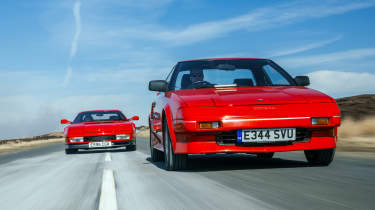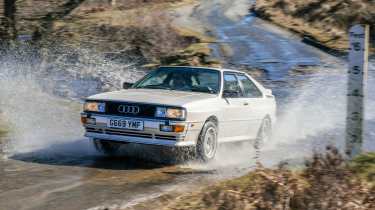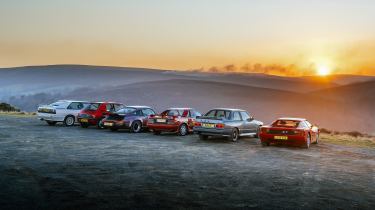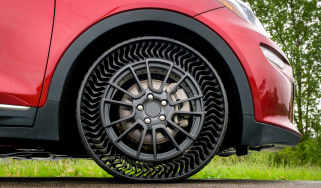Are classic cars as good as we remember them?
Looking back, were we viewing the ’80s and ’90s through rose-tinted glasses? Or were they in fact the definition of the thrill of driving?

The first evo Eras test was special. Perfect roads, crisp spring weather and a chance to get under the skin of six ’80s icons, cars my more senior colleagues earned their road-testing stripes in. Being evo’s resident whippersnapper, I’d be driving them all for the first time, and finding out whether the good old days really were as rosy as Dickie, John and Peter remembered. Turns out they might have been; I don’t think I’ve ever seen them smile so much on a shoot.
I assumed driving these cars would be more a novelty than a thrill, and while it’s true none of them deliver the mouth-drying moments modern stuff can, they’re demanding and rewarding in a different sense. Getting the best from them takes effort and skill, and you don’t need to drive fast for their characters to present themselves. The idiosyncrasies are right at the surface and totally colour the driving experience. It makes for a refreshing change of pace.
It took me some time to really get the appeal, but that’s probably because my first run out was in the 20V Quattro – a charming car but the most aloof of the group, with slow, squidgy responses and not much feedback and noise to make up for it. But then I had fabulous drives in the others. The E30 M3 was wonderfully poised and precise, the 205 GTI was a rattly, buzzing box of joy and the Mk1 MR2 was an absolute delight. My favourite car of the test in fact. It captured why we love small mid-engined sports cars with a fine, delicate touch and wacky 8-bit design that made you smile every time you climbed in.
Today’s cars get picked on for ballooning in size and weight – as they should – but stepping back four decades was a reminder that old cars have quirks of their own to manage. Most in the group were pleasingly compact, but with more slack in the steering and suspension you end up using more of the road, which negates some of that. You’re also more aware of how much mass there is and where it’s located. That was particularly pertinent in the 911 Carrera 3.2, which requires a real knack to drive quickly but is oh so sweet when you get it right.
The Testarossa was the halo car of the test and was just as spectacular as you’d imagine, mainly because of its engine. The sound and sense of it propelling you through raw mechanical energy is something you don’t feel in any new supercar. It didn’t like being rushed – even the simple act of changing gear required a patient, firm hand – but there’s a unique joy in that, finding a flow and being sympathetic to the car.

Even so, the lingering suspicion was that the best eras were yet to come, that future decades would still be full of varied, distinctive characters but developed further to deliver greater thrills. And that’s exactly what the ’90s gave us. What a group of cars, from the pert, perfect Clio 16V to the Lotus Elise S1, Impreza RB5, TVR Griffith 500 and right up to the defining Ferrari of the age, the F355. Our 911 of choice was the 996 Carrera, the first ever evo Car of the Year. I still daydream about them all.
It’s difficult to define any of the eras in blanket statements but the ’90s cars felt like a near-perfect meeting of useable performance, charisma and sheer desirability. They could be enjoyed in a wider window than the ’80s group, still involving at a calm pace but with higher peak rewards when you went looking for them. The Elise was a case in point, having some MR2 DNA in how it drove but ramping up precision and control to mesmerising effect. The same was true of the Impreza in comparison to the Quattro, the Clio compared with the 205, and the F355 after the Testarossa.

But not everything went in a positive direction, and I was surprised at how the 911 felt like a clean break from the earlier Carrera. It had composure to spare but was missing that raw edge of sound and connection. Perhaps it was overshadowed in a group of such strong characters, but I’ve had much more vivid, exciting drives in modern 911s, which isn’t what I expected. And the TVR? On the test we referred to it as the ‘anti-Porsche’. Lacking some polish dynamically, but making up for it – and more – with stacks of personality and a fierce, rumbling V8. It’s genuinely impossible to imagine having a boring drive in it.
That’s the crux of what makes these cars so special. And while I enjoyed the ’80s bunch less than my colleagues, the next decade brought some of the most memorable drives I had on any of the Eras tests. The good old days? They certainly felt pretty special to me.




